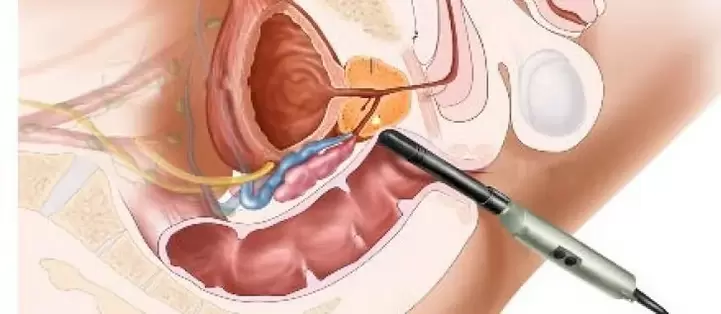
Chronic prostatitis is a serious problem. Even modern urology cannot answer many questions about this pathology. Experts believe that chronic prostatitis is a disease that results from a number of health problems, including tissue damage and dysfunction not only of the urinary tract and prostate, but also of other organs.
The pathology is diagnosed primarily in men of reproductive age. In elderly men, chronic prostatitis is often accompanied by benign tumors of the prostate.
Classification of the disease
The classification of prostatitis was developed by scientists at the U. S. National Institutes of Health in 1995:
%20and%20inflamed%20chronic%20prostatitis%20(right).webp)
- 1 type- acute bacterial prostatitis. It is diagnosed in 5% of cases of prostatitis.
- Type 2- bacterial chronic prostatitis.
- 3 types- chronic bacterial prostatitis. This pathology has another name - chronic pelvic pain syndrome.
- Type 3A- an inflammatory form of chronic prostatitis. It is diagnosed in 60% of cases of chronic prostatitis.
- Type 3B- a non-inflammatory form of chronic prostatitis. He was diagnosed in 30% of cases.
- 4 types- asymptomatic prostatitis.
There is also a classification for chronic prostatitis that was compiled in 1990.
Symptoms of chronic prostatitis
Discomfort and pain in the pelvis for more than 3 months are the main symptoms of chronic prostatitis.
In addition, urinary disorders and erectile dysfunction have been observed:
- pain occurs in the perineum, it can radiate to the anus, groin, inner thigh, sacrum, lower back, and scrotum. On the one hand, testicular pain is often not a symptom of chronic prostatitis;
- An erection does not occur despite proper conditions, but complete impotence is not observed;
- early ejaculation is observed in the early stages of the disease;
- frequent urination, urinary incontinence, pain and burning sensation during bladder emptying.
The clinical picture may differ depending on the type of chronic prostatitis.
infectious form:
- frequent urination at night;
- pain in the thigh, perineum, penis, and rectum aggravated by movement;
- painful urination;
- poor urine output.
Specific infectious:
- mucous secretions from the urethra;
- the above symptoms.
Non-infectious prostatitis:
- acute pain in the perineum;
- pain in the thighs and penis head;
- the pain is exacerbated by a forced interruption of sexual intercourse or a prolonged lack of intimate life.
Important!The disease is moving in waves. Symptoms may weaken or worsen, but their presence clearly indicates the presence of an inflammatory process.
Symptoms may vary depending on the stage of development of the pathology.

The following stages in the development of the pathology are distinguished:
- Exudative.The patient feels pain in the pubis, groin and scrotum. Frequent urination and discomfort occur after intercourse. An erection can hurt.
- Alternative.The pain intensifies, localizes in the groin, pubic area, and passes into the sacrum. Urination is accelerated, but without difficulty. An erection does not suffer.
- Reproducing.During exacerbation, urination becomes more common. The urine stream weakens.
- Cicatricial.Sclerosis of the prostate tissue occurs. There is a feeling of heaviness in the sacrum and pubic region. Increased urination. The erection weakens. Ejaculation may be completely absent.
Symptoms may vary depending on the course of the disease, but in any case gradually increase.
Causes of chronic prostatitis
Several factors can lead to chronic prostatitis. The disease is caused by infectious agents. The patient has hormonal, neurovegetative, immunological and hemodynamic disorders. It is influenced by biochemical factors, the return of urine to the prostate lobe, and impaired function of growth factors that are responsible for the proliferation of living cells.
Reasons influencing the development of the pathology:
- infections of the urogenital system;
- hypodynamics;
- irregular sex life;
- continuous catheterization of the bladder;
- regular hypothermia.
Developmentbacterial diseasespromotes intraprostatic urinary reflux.
Chronic bacterial prostatitisit develops in the background of neurogenic disorders of the pelvic floor muscles and the elements responsible for the function of the bladder wall, prostate and urethra.
Formationmyofascial trigger points, which are located near the urogenital system and prostate organs, can cause pelvic pain syndrome. Points resulting from certain diseases, surgeries, and injuries can cause pain in the pubic area, perineum, and adjacent areas.
Diagnosis of pathology
The presence of the syndrome allows the diagnosis of chronic prostatitis without particular difficulty. In some cases, however, the pathology may be asymptomatic. In this case, additional research methods are needed in addition to the usual examination and questioning of the patient.Neurological examination and study of the patient's immunological status are mandatory..
Important!Special questionnaires and questionnaires allow a more accurate definition of a patient’s subjective feelings and provide a complete picture of their health status, pain intensity, ejaculation, erection, and urinary incontinence.
Laboratory diagnostics
Laboratory diagnostics make it possible to distinguish between bacterial and bacterial forms of pathology, as well as to determine the type of pathogen and make the most accurate diagnosis.Chronic inflammation of the prostate is confirmed when the fourth urine sample or prostate secretion contains more than 10 leukocytes in the PZ or bacterial associations.If the number of leukocytes is increased but the bacteria are not discarded, the substance is tested for chlamydia or other STDs.
- Urethral secretions are sent to the laboratory to detect viral, fungal and bacterial flora, leukocytes and mucous membranes.
- Scraping from the urethra is examined by PCR. This allows the identification of sexually transmitted pathological agents.
- Perform microscopic examination of prostate secretion to count the number of macrophages, leukocytes, amyloid, and Trousseau-Lallemand bodies. Immunological testing and bacteriological testing are required. Determine the level of nonspecific antibodies.
- Blood sampling is performed ten days after digital rectal examination to determine PSA concentration. At rates above 4. 0 ng / ml, the patient undergoes a prostate biopsy to rule out oncology.
The diagnosis is made based on the results of the research.
Instrumental diagnostics

Clarification of the stage and form of the disease helps in the transrectal ultrasound of the gland. Ultrasound makes it possible to rule out other diagnoses, to check the effectiveness of the treatment, and to determine the size, echostructure, homogeneity, and density of the seminal vesicles. Urodynamic studies and pelvic floor muscle myography allow the detection of infrared obstruction and neurogenic disorders that often accompany pathology.
Tomography and MRI are used to make a differential diagnosis, especially for prostate cancer. These methods reveal violations of the pelvic organs and the spine.
Differential diagnosis
Differential diagnosis is important because there is a risk that the patient will have a more serious illness.
Differential diagnosis is performed in the following diseases:
- pseudodysynergia, functional disorder of the detrusor-sphincter system, bladder dysfunction of neurogenic origin, complex regional pain syndrome;
- bladder stenosis, hypertrophic lesions in the bladder neck, prostate adenoma;
- osteitis of the vulva, cystitis;
- rectal pathology.
If symptoms occur, the prostate gland should be examined by a urologist or andrologist. Perform an ultrasound scan. If necessary, a biopsy of the prostate gland is prescribed.
Pathological treatment methods
Chronic prostatitis is treated by a urologist or andrologist. Therapy is done in a complex way. The correction depends on the patient's lifestyle, thinking characteristics and habits. It’s important to exercise more, minimize alcohol consumption, get rid of nicotine addiction, eat right, and normalize our sex lives. However, it will not work without basic therapy. Taking medication is the main condition for complete recovery.
Indications for hospital treatment
Most often, treatment is performed on an outpatient basis. But in cases where the disease cannot be corrected and is prone to relapse, the patient is referred to a hospital where treatment is more effective.
Method of medical treatment
This method is used to eliminate an existing infection, normalize blood circulation, improve the drainage of the prostate lobes, and improve the hormonal background and immune status. Therefore, doctors prescribe antibiotics, vasodilators, immunomodulators, anticholinergics, and anti-inflammatory drugs.
If the pathology is bacterial in nature, antibiotics are definitely recommended. The drug is prescribed based on the results of bacterial culture of prostate secretion.This makes it possible to isolate the pathogen and then determine its susceptibility to a particular drug. With a well-designed regimen, the effectiveness of the treatment reaches 90%.
A short course of antibiotics is prescribed in bacterial form. They will only continue if the system gives a positive result. The effectiveness of the therapy is about 40%.
In case of chronic pelvic pain, the duration of antibiotics is up to one month. With positive dynamics, treatment is continued for another month. If there is no effect, the drug is replaced with another that may be more effective.
Antibacterial agents belonging to the group of fluoroquinolones are the main drugs for the treatment of pathology.They have a high bioavailability, are active against most Gram-negative bacteria, ureaplasmas and chlamydia, and accumulate in the tissues of the prostate gland.
If treatment with fluoroquinolones is ineffective, penicillins may be prescribed.
Antibacterial drugs are used for prophylactic purposes.
Therapy with α-blockers is prescribed after antibiotic treatment.This treatment strategy is effective in patients with persistent obstructive and irritating symptoms.
If urinary incontinence and pain persist, tricyclic antidepressants may be prescribed that have analgesic effects.
In the event of a severe urinary incontinence, a urodynamic examination should be performed prior to initiating therapy and based on the results obtained.
Non-drug therapy
Non-pharmacological methods allow the concentration of antibacterial drugs in the glandular tissues to be increased, but it is not recommended to exceed the dose.
For this purpose, the following methods are used:
- electrophoresis;
- Laser therapy;
- phonophoresis;
- Microwave hyperthermia (applied transrectally).
When using the latter method, the temperature is selected individually. The temperature set in the range of 39-40 degrees allows to increase the concentration of the drug in the body, activates the immune system at the cellular level, eliminates bacteria, relieves congestion. Increasing the range to 40-45 degrees allows a sclerosing and analgesic effect to be achieved.
Laser and magnetic therapy are used in combination. Its effect is similar to that of the above methods, but it also has a biostimulating effect on the organ.
Transrectal massage is performed only in the absence of contraindications.

Surgical method
Chronic prostatitis usually does not require surgery. Exceptions are complications that endanger the patient's health and life. Modern surgical treatment allows the use of endoscopic surgery. Minimally invasive. Rehabilitation is faster and there is minimal damage to the body.
The surgical method is prescribed in the following cases:
- prostate sclerosis;
- prostate adenoma;
- nuclear tuberculosis sclerosis;
- calcification in the prostate.
Important!Surgery is contraindicated in the acute stage. Surgical treatment is prescribed by the surgeon based on the results of the examination and the general clinical picture.
Prognosis of chronic prostatitis
Doctors are wary of predicting the outcome of the disease. Complete recovery is rare. Basically, chronic prostatitis enters the stage of long-term remission. Symptoms disappear and urine and blood counts return to normal. In order to prevent chronic prostatitis from becoming more active and causing complications, all recommendations of a specialist should be followed.


























